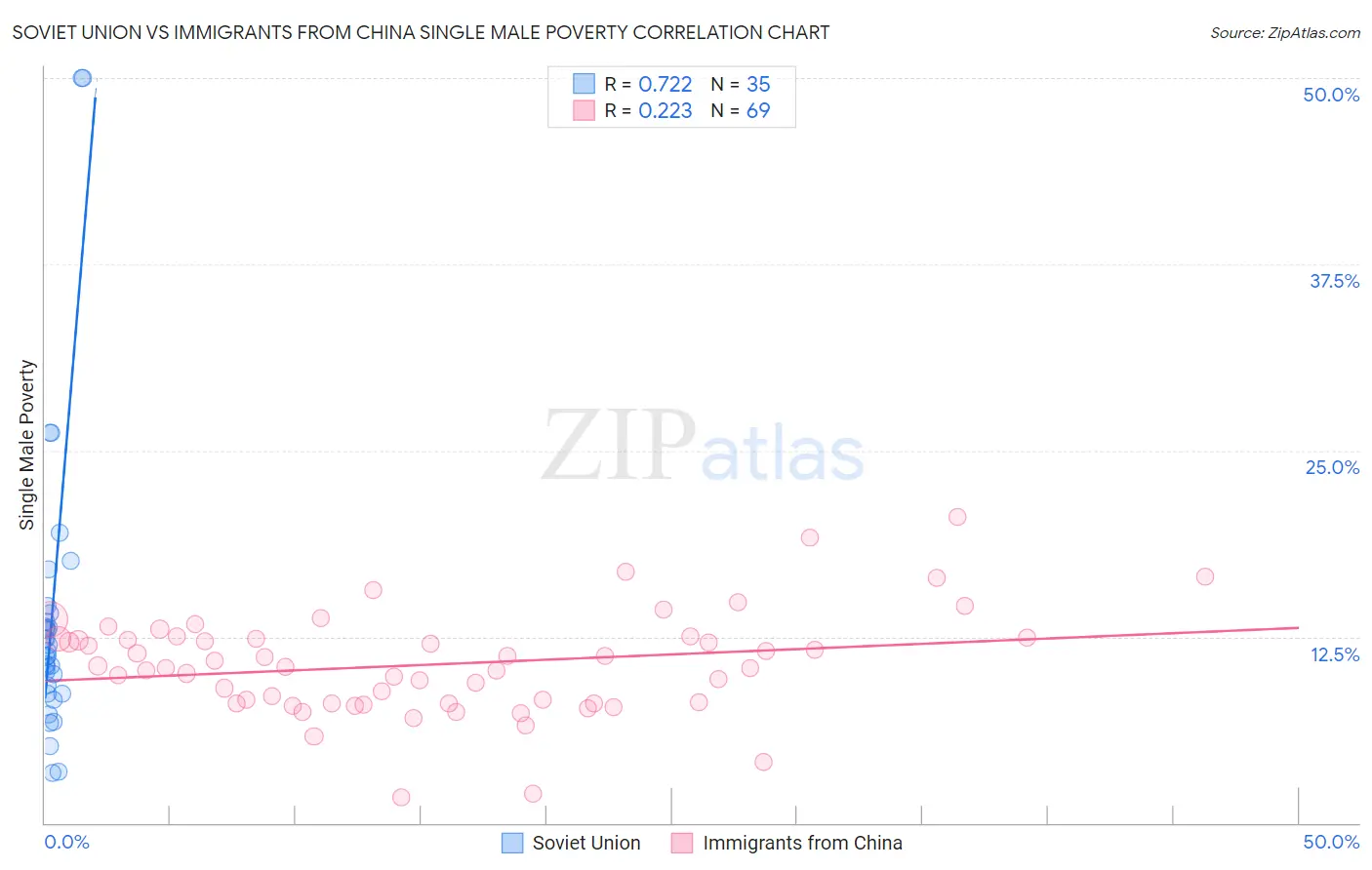Soviet Union vs Immigrants from China Single Male Poverty
COMPARE
Soviet Union
Immigrants from China
Single Male Poverty
Single Male Poverty Comparison
Soviet Union
Immigrants from China
11.5%
SINGLE MALE POVERTY
100.0/ 100
METRIC RATING
39th/ 347
METRIC RANK
11.4%
SINGLE MALE POVERTY
100.0/ 100
METRIC RATING
27th/ 347
METRIC RANK
Soviet Union vs Immigrants from China Single Male Poverty Correlation Chart
The statistical analysis conducted on geographies consisting of 42,355,679 people shows a strong positive correlation between the proportion of Soviet Union and poverty level among single males in the United States with a correlation coefficient (R) of 0.722 and weighted average of 11.5%. Similarly, the statistical analysis conducted on geographies consisting of 395,740,575 people shows a weak positive correlation between the proportion of Immigrants from China and poverty level among single males in the United States with a correlation coefficient (R) of 0.223 and weighted average of 11.4%, a difference of 0.79%.

Single Male Poverty Correlation Summary
| Measurement | Soviet Union | Immigrants from China |
| Minimum | 3.3% | 1.7% |
| Maximum | 50.0% | 20.6% |
| Range | 46.7% | 18.8% |
| Mean | 14.0% | 10.6% |
| Median | 11.5% | 10.5% |
| Interquartile 25% (IQ1) | 8.7% | 8.0% |
| Interquartile 75% (IQ3) | 14.1% | 12.4% |
| Interquartile Range (IQR) | 5.4% | 4.4% |
| Standard Deviation (Sample) | 10.3% | 3.4% |
| Standard Deviation (Population) | 10.2% | 3.4% |
Demographics Similar to Soviet Union and Immigrants from China by Single Male Poverty
In terms of single male poverty, the demographic groups most similar to Soviet Union are Sri Lankan (11.5%, a difference of 0.090%), Immigrants from Singapore (11.4%, a difference of 0.15%), Immigrants from Serbia (11.4%, a difference of 0.20%), Immigrants from South Eastern Asia (11.4%, a difference of 0.24%), and Immigrants from Ethiopia (11.4%, a difference of 0.27%). Similarly, the demographic groups most similar to Immigrants from China are Immigrants from Asia (11.4%, a difference of 0.070%), Immigrants from Egypt (11.4%, a difference of 0.17%), Iranian (11.4%, a difference of 0.23%), Immigrants from Iran (11.4%, a difference of 0.32%), and Immigrants from Eastern Asia (11.4%, a difference of 0.40%).
| Demographics | Rating | Rank | Single Male Poverty |
| Bolivians | 100.0 /100 | #23 | Exceptional 11.2% |
| Indians (Asian) | 100.0 /100 | #24 | Exceptional 11.3% |
| Maltese | 100.0 /100 | #25 | Exceptional 11.3% |
| Immigrants | Japan | 100.0 /100 | #26 | Exceptional 11.3% |
| Immigrants | China | 100.0 /100 | #27 | Exceptional 11.4% |
| Immigrants | Asia | 100.0 /100 | #28 | Exceptional 11.4% |
| Immigrants | Egypt | 100.0 /100 | #29 | Exceptional 11.4% |
| Iranians | 100.0 /100 | #30 | Exceptional 11.4% |
| Immigrants | Iran | 100.0 /100 | #31 | Exceptional 11.4% |
| Immigrants | Eastern Asia | 100.0 /100 | #32 | Exceptional 11.4% |
| Immigrants | Vietnam | 100.0 /100 | #33 | Exceptional 11.4% |
| Immigrants | Ethiopia | 100.0 /100 | #34 | Exceptional 11.4% |
| Immigrants | South Eastern Asia | 100.0 /100 | #35 | Exceptional 11.4% |
| Immigrants | Serbia | 100.0 /100 | #36 | Exceptional 11.4% |
| Immigrants | Singapore | 100.0 /100 | #37 | Exceptional 11.4% |
| Sri Lankans | 100.0 /100 | #38 | Exceptional 11.5% |
| Soviet Union | 100.0 /100 | #39 | Exceptional 11.5% |
| Immigrants | Korea | 100.0 /100 | #40 | Exceptional 11.5% |
| Immigrants | Iraq | 99.9 /100 | #41 | Exceptional 11.5% |
| Egyptians | 99.9 /100 | #42 | Exceptional 11.5% |
| Immigrants | Peru | 99.9 /100 | #43 | Exceptional 11.5% |